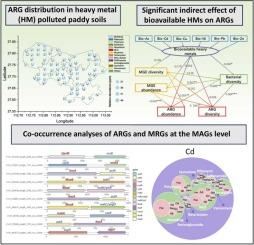当前位置:
X-MOL 学术
›
J. Hazard. Mater.
›
论文详情
Our official English website, www.x-mol.net, welcomes your
feedback! (Note: you will need to create a separate account there.)
Significant effects of bioavailable heavy metals on antibiotic resistome in paddy soils as revealed by metagenomic analysis
Journal of Hazardous Materials ( IF 12.2 ) Pub Date : 2024-11-19 , DOI: 10.1016/j.jhazmat.2024.136587 Jie Hou, Ye Li, Mengqi Liu, Zheng Qu, Zhaolin Du, Yi An, Fengxia Yang, Yanpo Yao
Journal of Hazardous Materials ( IF 12.2 ) Pub Date : 2024-11-19 , DOI: 10.1016/j.jhazmat.2024.136587 Jie Hou, Ye Li, Mengqi Liu, Zheng Qu, Zhaolin Du, Yi An, Fengxia Yang, Yanpo Yao

|
Heavy metals (HMs) act as a long-term selective pressure for the emergence and maintenance of antibiotic resistance genes (ARGs) in agricultural soils. However, the effects of HMs on ARG distributions in paddy soils and the underlying mechanisms remain unclear. In this study, 74 soil samples were collected from the paddy fields to explore the impact of HMs on ARG profiles. A total of 468 ARGs were detected in HM-contaminated soils. Variation partitioning analysis (VPA) and redundancy analysis (RDA) demonstrated that the bioavailable HMs contributed more significantly to ARG composition compared to the total HM content (8.59% vs. 3.97%). Structural equation models (SEMs) showed that bioavailable HMs affected ARGs mainly by negatively altering the microbial diversity. Furthermore, the co-occurrence analysis of ARGs and metal resistant genes (MRGs) was further performed at the metagenome-assembled genomes (MAGs) level. Consequently, 1145 MAGs that assigned to 29 bacterial phyla were found to concurrently harbor ARG and MRG, with the bacterial phyla Pseudomonadota being predominant ARG-MRG-carrying microbes for most coexistence types of ARGs and MRGs, i.e., multidrug-As, polymyxin-Cd, Quinolone-Cd, Beta-lactam-Pb, and multidrug-Zn. Our findings highlight that the extensive coexistence of ARG-MRG in microbial genomes is an important reason for the ARG pollution in HM-contaminated paddy soils.
更新日期:2024-11-19


















































 京公网安备 11010802027423号
京公网安备 11010802027423号